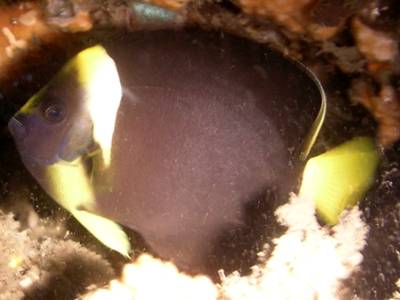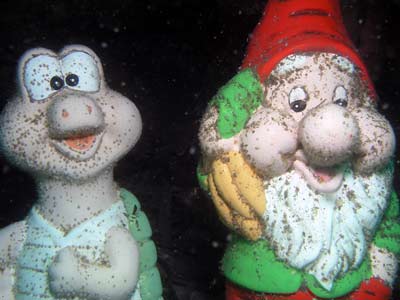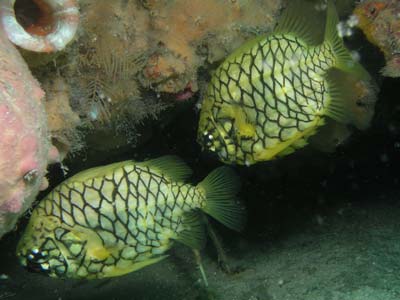Michael McFadyen's Scuba Diving - Fly Point Drift
 |
| Fly Point - dive starts at stairs middle left, ends at beach behind trees |
One of the best dives at Nelson Bay (Port Stephens) is Fly Point. Fly Point is part of the Fly Point/Halifax Park Aquatic Reserve which extends from just south of Fly Point north to past Halifax Park and 500 metres seaward. Fishing is banned in the reserve (except from two wharves and the beach in between these wharves) as is spearfishing and collecting. Fly Point is located to the north-east of the main marina and is reached by going past the roundabout, along the beach front and where the main road turns to the right, go straight ahead. There is a small car park here opposite a large park where you can gear up.
The Fly Point to Sewage Pipe Drift. You can also do a drift dive staying totally within the Fly Point area.
The car park can get busy when dives are done at high tide but if you are doing the dive on an incoming tide, you will find it easier to get a spot. However, it is still worth getting there early on summer weekends, especially on long weekends. This dive is done on an incoming tide. Since you are probably doing this dive so you can fit in another dive (say Halifax or here) at high tide, I would plan to do it about three hours before high tide. This gives you heaps of time for a good surface interval.
When tides are very high (say 1.8 to 2.0 metres), the water moves very fast but when the tides are about 1.5 metres it is quite easy to swim against.
There is a set of stairs at Fly Point that leads down from the car park to the water's edge where there is a path cleared of rocks into the water. I would walk to the east along the beach to the spot where you can see a cleared area in the water. This gives you a bit more to explore. Once in the water, descend straight away and swim out due north. You will see large schools of bream, small snapper, luderick, mullet, trumpeter as well as whiting and flathead. One of the best snorkels you will ever do.
 |
Yellowtail Angelfish
This photo taken at Shiprock but identical
to one seen at Fly Point March 2005 |
The bottom gradually slopes to 10 metres and then drops to 11 metres. Once here drift with the current and you will soon see a sandy slope on your right and then encounter a small wall with some small overhangs. This is the start of the normal dive. The reef runs to the south-west or west. The reef is not continuous and is broken up with sand spots and the wall in most places becomes a prominent slope. You will find large schools of yellowtail, bream, snapper here as well as mosaic leatherjackets.
Look under the the small overhangs and you may find other surprises. I have seen up to eight pineapplefish in one spot, two cowries and numerous mosaic and moray eels here. In this area there are sometimes tropical fish such as small long-finned bannerfish, coral trout (or similar), yellow-tail angelfish (seen a number of times), other species of butterflyfish and other species that I have not been able to identify. I even know of someone who found 10 crayfish under one overhang, although I have only seen one at a time. Look under the small overhangs as you go. You will almost certainly see some pineapplefish in this area (they seem to be a much brighter yellow than those from Sydney). Have a look at everything as you go, there is so much to see.
 |  |
| Two of the gnomes that can be seen at Fly Point | Two sweet chromodorids mating at Fly Point |
There is also a plaque in this area. I do not know what it says as the lettering is faint and not raised. It appears to be a poem about Fly Point (?). There is often some garden gnomes near the plaque or under the overhangs. In October 2006 there were three. There are also the remains of many scientific experiments on the floor. These are stainless steel rods in the shape of a box but they are now covered in heavy growth and as such, the experiment seems to have finished ages ago.
You will have been in the water about 13 minutes. Do not drop deeper and stay close to the main wall. You will be heading mostly west and gradually it turns a bit to the south. Do not go deeper than 13 metres, especially if the current is flowing very strong. Here there is a low wall or slope. Follow this south till the wall disappears. It will be about 16 minutes on 1.5 metre tide and shorter (probably) on a larger tide. Along the wall there are some small bommies off the wall. There are some spots where the fishlife is prolific. Luderick, bream and small snapper are very common in large numbers.
Once you pass the end of the wall, you can head east and it will take you to the northern end of the beach to the south of Fly Point. An alternative if the current is not too strong is to head north once you get back in the five metre depth (when you hit sand) and go this way for another 6 or so minutes. From here head east till you can stand up and exit the water.
 |  |
Two Pineapplefish at Fly Point
Photo taken March 2005 | Two more Pineapplefish at Fly Point
Photo taken October 2006 |
This is a very good shore dive, but only suitable for more experienced divers or those under close supervision of experienced divers.
MORE PHOTOS
Photos of Port Stephens Nudibranchs
Photos of Port Stephens More Unusual Species
Photos of Port Stephens Spindle Cowries
| 
 v6.00.307 © 2003-2005
v6.00.307 © 2003-2005